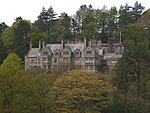Grey Stone of Trough
1897 establishments in EnglandBoundary markersBuildings and structures in Ribble ValleyBuildings and structures in the City of LancasterForest of Bowland ... and 2 more
Grade II listed buildings in LancashireLancashire building and structure stubs

The Grey Stone of Trough is an historic boundary marker in Bowland Forest High, in the Trough of Bowland, Lancashire, England. A Grade II listed structure, erected in 1897 and standing on Trough Road, it marks the line of the pre-1974 county boundary between Lancashire and the West Riding of Yorkshire. Historically, the Trough marked the westernmost boundary of the ancient Lordship of Bowland. It is in sandstone and has a triangular section with inscriptions on the two sides that face the road.
Excerpt from the Wikipedia article Grey Stone of Trough (License: CC BY-SA 3.0, Authors, Images).Grey Stone of Trough
Trough Road, Lancaster Over Wyresdale
Geographical coordinates (GPS) Address Nearby Places Show on map
Geographical coordinates (GPS)
| Latitude | Longitude |
|---|---|
| N 53.97226 ° | E -2.5774 ° |
Address
Trough Road
Trough Road
BB7 3BJ Lancaster, Over Wyresdale
England, United Kingdom
Open on Google Maps










